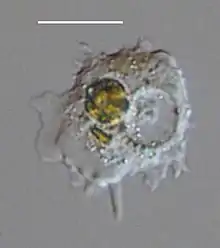Acropora
Acropora ist die artenreichste Gattung der Steinkorallen (Scleractinia).
| Acropora | ||||||||||||
|---|---|---|---|---|---|---|---|---|---|---|---|---|
.jpg.webp)
| ||||||||||||
| Systematik | ||||||||||||
| ||||||||||||
| Wissenschaftlicher Name | ||||||||||||
| Acropora | ||||||||||||
| Oken, 1815 |
Während es in der Karibik nur drei Arten gibt, und die Acroporen um Hawaii fehlen, gibt der australische Steinkorallenspezialist Veron allein für Ostaustralien 73 Arten an. Die genaue Artenzahl im gesamten Indopazifik ist unbekannt, da es wegen der vernetzten Evolution dieser Gattung eine Vielzahl von Formen gibt, deren Artstatus nicht bestimmt werden kann.
Merkmale
Die Polypen der Acroporen werden nur ein bis drei Millimeter lang. Charakteristisch ist ein größerer Polyp am Ende jedes Zweiges. Die Endpolypen haben oft auch eine besondere Färbung und geben der meist eher bräunlichen Korallenkolonie Farbe. Die axialen Polypen am Ende der Zweige haben sechs, die radialen Polypen zwölf[1] Tentakel, die sie nachts zum Planktonfang herausstrecken.
Im deutschen nennt man die Acroporen je nach Wuchsform oft Geweihkorallen oder Tischkorallen. Wie die meisten anderen Steinkorallen leben sie in einer symbiotischen Beziehung mit kleinen Algen (Zooxanthellen), die die Acroporen mit Nährstoffen versorgen. Die Acroporen sind deshalb auf helle Standorte angewiesen. Die symbiotische Beziehung von A. tenuis mit der Algenspezies Breviolum minutum (Symbiodiniaceae) wurde 2021 in vitro im Detail beschrieben.[2][3]
Acroporen dominieren an vielen Stellen die Riffe und bilden regelrechte Monokulturen. Sie wachsen sehr schnell und haben einen geschätzten Anteil von 25 % an der Riffbildung. Bei Barbados hat man bei Acropora cervicornis einen jährlichen Zuwachs von 26 Zentimeter festgestellt. Während die Blumentiere im flachen Wasser und auf den Riffdächern meist busch- oder geweihförmig wachsen, bilden sie an den Riffabhängen oft tischförmige Stöcke und wachsen, um noch möglichst viel Licht aufzufangen, waagerecht nach außen.
Arten
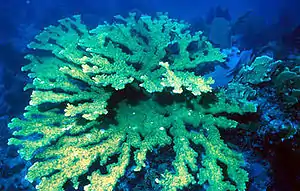
(Acropora palmata)
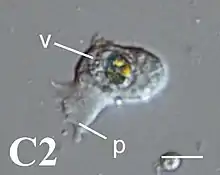
.jpg.webp)
_forest.jpg.webp)
- Acropora humilis-Gruppe
- Acropora humilis (Dana, 1846)
- Acropora gemmifera (Brook, 1892)
- Acropora monticulosa (Brueggemann, 1879)
- Acropora lovelli-Gruppe
- Acropora bushyensis Veron & Wallace, 1984
- Acropora glauca (Brook, 1893)
- Acropora lovelli Veron & Wallace, 1984
- Acropora verweyi Veron & Wallace, 1984
- Acropora robusta-Gruppe
- Acropora danai (Milne-Edwards & Haime, 1860)
- Acropora listeri (Brook, 1893)
- Acropora nobilis (Dana, 1846)
- Acropora palmerae Wells, 1954
- Acropora polystoma (Brook, 1891)
- Acropora robusta (Dana, 1846)
- Acropora formosa-Gruppe
- Acropora acuminata (Verrill, 1864)
- Acropora abrolhosensis Veron, 1985
- Acropora formosa (Dana, 1846)
- Acropora grandis (Brook, 1892)
- Acropora valenciennesi (Milne-Edwards & Haime, 1860)
- Acropora horrida-Gruppe
- Acropora austera (Dana, 1846)
- Acropora horrida (Dana, 1846)
- Acropora kirstyae Veron & Wallace, 1984
- Acropora microphthalma (Verrill, 1869)
- Acropora tortuosa (Dana, 1846)
- Acropora vaughani Wells, 1954
- Acropora aspera-Gruppe
- Acropora aspera (Dana, 1846)
- Acropora millepora (Ehrenberg, 1834)
- Acropora pulchra (Brook, 1891)
- Acropora selago-Gruppe
- Acropora dendrum (Bassett-Smith, 1890)
- Acropora donei Veron & Wallace, 1984
- Acropora selago (Studer, 1878)
- Acropora tenuis (Dana, 1846)[2]
- Acropora yongei Veron & Wallace, 1984
- Acropora hyacinthus-Gruppe, Tischkorallen
 Acropora cytherea
Acropora cytherea- Acropora anthocercis (Brook, 1893)
- Acropora cytherea (Dana, 1846)
- Acropora hyacinthus (Dana, 1846)
- Acropora microclados (Ehrenberg, 1834)
- Acropora paniculata Verrill, 1902
- Acropora spicifera (Dana, 1846)
- Acropora latistellata-Gruppe
- Acropora aculeus (Dana, 1846)
- Acropora azurea Veron & Wallace, 1984
- Acropora latistella (Brook, 1892)
- Acropora nana (Studer, 1878)
- Acropora sabulata (Dana, 1846)
- Acropora nasuta-Gruppe
- Acropora cerealis (Dana, 1846)
- Acropora lutkeni Crossland, 1952
- Acropora nasuta (Dana, 1846)
- Acropora secale (Studer, 1878)
- Acropora valida (Dana, 1846)
- Acropora divaricata-Gruppe
- Acropora clathrata (Brook, 1891)
- Acropora divaricata (Dana, 1846)
- Acropora echinata-Gruppe
- Acropora carduus (Dana, 1846)
- Acropora echinata (Dana, 1846)
- Acropora elseyi (Brook, 1892)
- Acropora longicyathus (Milne-Edwards & Haime, 1860)
- Acropora subglabra (Brook, 1891)
- Acropora loripes-Gruppe
_in_Acropora_loripa_(Hard_coral).jpg.webp)
- Acropora caroliniana Nemenzo, 1976
- Acropora chesterfieldensis Veron & Wallace, 1984
- Acropora granulosa (Milne-Edwards & Haime, 1860)
- Acropora loripes (Brook, 1892)
- Acropora willisae Veron & Wallace, 1984
- Acropora florida-Gruppe
- Acropora florida (Dana, 1846)
- Acropora sarmentosa (Brook, 1892)
- Karibische Gruppe
- Hirschgeweihkoralle (Acropora cervicornis) (Lamarck, 1816)
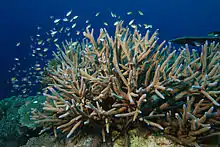 Hirschgeweihkoralle
Hirschgeweihkoralle
(Acropora cervicornis) - Elchgeweihkoralle (Acropora palmata) (Lamarck, 1816)
- Acropora prolifera (Lamarck, 1816)
- Hirschgeweihkoralle (Acropora cervicornis) (Lamarck, 1816)
- incertae sedis
- Acropora abrotanoides (Lamarck)
- Acropora akajimensis Veron, 1990
- Acropora arabensis Hodgson & Carpenter, 1996
- Acropora awi Wallace & Wolstenholme, 1998
- Acropora batunai Wallace, 1997
- Acropora branchi Riegl, 1995
- Acropora cardenae Wells, 1986
- Acropora echinata (Dana, 1846)
- Acropora convexa
- Acropora copiosa Nemenzo, 1967
- Acropora crassa (Milne-Edwards & Haime, 1860)
- Acropora cymbicyathus (Brook)
- Acropora delicatula (Brook)
- Acropora derawaensis Wallace, 1997
- Acropora desalwii Wallace, 1994
- Acropora digitifera (Dana, 1846)
- Acropora diversa (Brook)
- Acropora elegans (Milne-Edwards & Haime, 1860)
- Acropora eurystoma (Klunzinger, 1879)
- Acropora exquisita Nemenzo, 1971
- Acropora halmaherae Wallace & Wolstenholme, 1998
- Acropora hemprichii (Ehrenberg, 1834)
- Acropora hoeksemai Wallace, 1997
- Acropora indiana Wallace, 1994
- Acropora indonesia Wallace, 1997
- Acropora insignis Nemenzo, 1967
- Acropora intermedia (Brook, 1891)
- Acropora irregularis (Brook, 1892)
- Acropora jacquelinae Wallace, 1994
- Acropora kosurini Wallace, 1994
- Acropora loisetteae Wallace, 1994
- Acropora lokani Wallace, 1994
- Acropora magnifica Nemenzo, 1971
- Acropora mirabilis Quelch, 1886
- Acropora mossambica Riegl, 1995
- Acropora multiacuta Nemenzo, 1967
- Acropora natalensis Riegl, 1995
- Acropora ocellata (Klunzinger, 1879)
- Acropora parilis Quelch, 1886
- Acropora pharaonis (Milne-Edwards & Haime, 1860)
- Acropora plumosa Wallace & Wolstenholme, 1998
- Acropora pocilloporina Wallace, 1994
- Acropora pruinosa (Brook, 1893)
- Acropora rambleri Bassett-Smith, 1890
- Acropora reticulata (Brook, 1893)
- Acropora rosaria (Dana, 1846)
- Acropora rudis (Rehberg, 1892)
- Acropora russelli Wallace, 1994
- Acropora samoensis (Brook, 1891)
- Acropora schmitti Wells, 1950
- Acropora sekiseiensis Veron, 1990
- Acropora simplex Wallace & Wolstenholme, 1998
- Acropora solitaryensis Veron & Wallace, 1984
- Acropora sordiensis Riegl, 1995
- Acropora splendida Nemonzo
- Acropora squarrosa (Ehrenberg, 1834)
- Acropora stoddarti Pillai & Scheer, 1976
- Acropora striata (Verrill, 1866)
- Acropora subulata (Dana, 1846)
- Acropora suharsonoi Wallace, 1994
- Acropora sukarnoi Wallace, 1997
- Acropora surculosa (Dana, 1846)
- Acropora tanegashimensis Veron, 1990
- Acropora tenella (Brook, 1892)
- Acropora teres (Verrill, 1866)
- Acropora torihalimeda Wallace, 1994
- Acropora tumida Verrill, 1866
- Acropora turaki Wallace, 1994
- Acropora variabilis (Klunzinger, 1879)
- Acropora wallacea Veron, 1990
Bedrohung
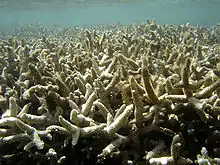
Wie andere Steinkorallenarten sind auch Acropora von der im Zuge der durch die menschengemachte globale Erwärmung verursachten permanenten Erwärmung und Versauerung der Meere weltweit durch "Korallenbleiche" schwer bedroht.
Aquarienhaltung
Acroporen können auch in gut gepflegten Meerwasseraquarien kultiviert werden. Sie erreichen hier bei guten Wasserbedingungen Längenzuwächse von 16 Zentimeter im Jahr. Durch Fragmentation größerer Kolonien können sie leicht künstlich vermehrt werden. Inzwischen gibt es viele Korallenzüchter, die Acroporen vermehren und versuchen möglichst farbige Formen zu erhalten. Es ist heute nicht mehr nötig Acroporen aus Korallenriffen zu importieren.
Literatur
- Julian Sprung: Korallen. Dähne Verlag, 2000, ISBN 3-921684-87-0
- S. A. Fosså, A. J. Nilsen: Korallenriff-Aquarium. Band 4, Birgit Schmettkamp Verlag, Bornheim, ISBN 3-928819-05-4
- Erhardt/Moosleitner: Mergus Meerwasser-Atlas. Band 2. Mergus-Verlag, Melle, 1997, ISBN 3-88244-112-7
- Erhardt/Baensch: Mergus Meerwasser-Atlas. Band 4. Mergus-Verlag, Melle, 1998, ISBN 3-88244-023-6
- Erhardt/Baensch: Mergus Meerwasser-Atlas. Band 5. Mergus-Verlag, Melle, 2000, ISBN 3-88244-115-1
Weblinks
- Coral Hub: Acropora
- The Corals of the Genus Acropora (en.)
- Acroporen im Meerwasserlexikon (dt.)
- Integrated Taxonomic Information System Acropora Oken, 1815
Einzelnachweise
- Elizabeth M. Hemond, Stefan T. Kaluziak, Steven V. Vollmer: The genetics of colony form and function in Caribbean Acropora corals. In: BMC Genomics. Band 15, Nr. 1, 17. Dezember 2014, doi:10.1186/1471-2164-15-1133, PMID 25519925, PMC 4320547 (freier Volltext).
- Kaz Kawamura, Satoko Sekida, Koki Nishitsuji, Eiichi Shoguchi, Kanako Hisata, Shigeki Fujiwara, Noriyuki Satoh: In vitro Symbiosis of Reef-Building Coral Cells With Photosynthetic Dinoflagellates, in: Front. Mar. Sci., 14. Juli 2021, doi:10.3389/fmars.2021.706308
- Nadja Podbregar: So fangen Korallen ihre Symbionten – Forscher beobachten erstmals die Aufnahme von Algen durch Korallenzellen, auf: scinexx.de vom 22. Juli 2021
